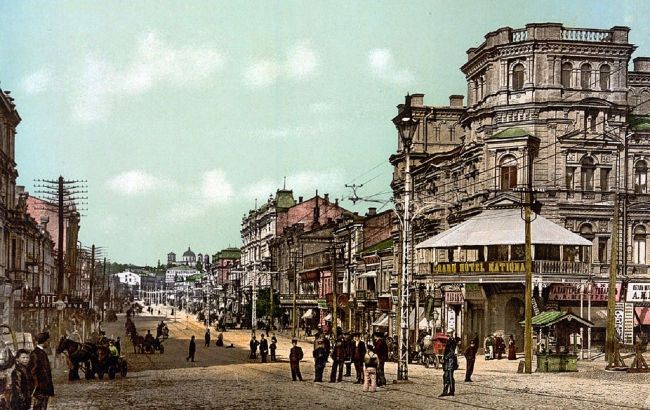What Khreshchatyk looked like before the chestnut trees: Rare archival photos
 What did the old Khreshchatyk look like (photo: Wikipedia)
What did the old Khreshchatyk look like (photo: Wikipedia)
The chestnut tree is the main Kyiv tree, which has long been a symbol of the Ukrainian capital. But what did Khreshchatyk look like before the chestnut-lined alleys appeared?
RBC-Ukraine offers a look at rare archival photos of Khreshchatyk, where chestnuts were still absent.
Chestnuts: the green symbol of Kyiv
The chestnut has long been an inseparable part of Kyiv’s landscape, and a living symbol of the city. Its image adorned the city’s coat of arms during the Soviet era, and the "Kyiv Waltz," with its lyrics about the chestnut blossoms, became an anthem for Kyivites.
Though the tree's homeland is considered to be Greece, chestnuts appeared in Kyiv as early as the 18th century. They decorated monastery courtyards and estates, and later spread to the streets and parks.
In Europe, chestnuts had their own festivals, such as in London, where they were celebrated since 1799. In Kyiv, this tradition never took root, but the history of chestnuts here is no less fascinating.


Khreshchatyk in 1890-1900 (photo: starkiev.com)
How chestnuts appeared in Kyiv
There are several legends about how chestnuts came to Kyiv. The most popular one says that in 1842, Governor-General Bibikov brought these trees from the Balkans before Tsar Nicholas I's visit. However, the monarch didn't like the exotic trees and ordered them to be uprooted, replacing them with poplars.
But the people of Kyiv saved the trees by transplanting them into their yards. Another version claims that chestnuts were grown on monastery grounds as early as the 17th-18th centuries, solely for the beauty of their flowers. Old chronicles mention "wild chestnuts" that provided dense shade during hot weather.
Some of these trees, especially those in monasteries, are over 300 years old. According to legend, the oldest chestnut in Kyiv was planted by Petro Mohyla near the Kytaiv Monastery.
 Khreshchatyk in the 1920s (photo: starkiev.com)
Khreshchatyk in the 1920s (photo: starkiev.com)

Khreshchatyk in 1941 (photo: starkiev.com)
Chestnuts as part of the city's culture
From monastery gardens, chestnuts gradually spread to city streets and botanical gardens. It is known that even during the time of the Russian Empire, authorities recommended planting linden trees, chestnuts, and poplars in central Kyiv.
After World War II, architect Dobrovolskyi implemented a greening project for Khreshchatyk, creating a chestnut-linden alley. This green strip became a favorite motif in artists' paintings and poets' verses.
Once again, chestnuts bloom,
The Dnipro waves crash.
Youth, my dear,
You are my happiness.
("Kyiv Waltz," O. Malishko - P. Mayboroda)


Khreshchatyk before 1941 (photo: Facebook.com/Spraha: Kyiv is interesting)
Sources: Facebook group Facebook.com/Spraha: Kyiv is interesting, website starkiev.com, Wikipedia.

